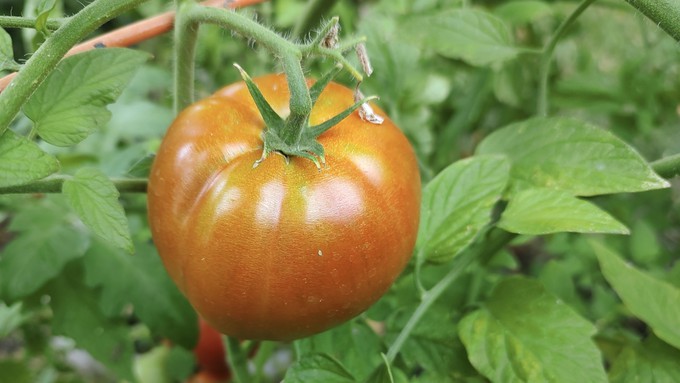
Triple-digit temperatures can keep tomatoes from turning full red, says Farmer Fred

Jetsetter tomato seems stuck on orange instead of turning full red. Blame the heat. Debbie Arrington
It seems counterintuitive; instead of ripening faster as days get hotter, tomatoes seem to slow down.
A lot of Sacramento-area gardeners are experiencing that phenomenon firsthand as they watch their tomatoes very very very slowly change from pinkish to full red.
Farmer Fred Hoffman, lifetime master gardener and award-winning radio host/podcaster, made that point in his weekly newsletter and “Garden Basics” podcast.
“Many area gardeners are wondering about the lack of color of their tomatoes now, in late summer,” Hoffman said. “Blame the triple-digit heat spikes that have occurred coast to coast for the slowdown this summer.”
According to university research, a couple of factors are in play. In late summer, tomato vines may have fewer leaves. Less foliage means less photosynthesis, which means less energy and slower growth for the plant. Without that boost of energy, its green tomatoes take longer to grow to size and ripen.
In addition, red pigments can’t form properly in triple-digit heat. Yellow and orange pigments seem to do OK, which leads to ripe tomatoes with splotches. They’re fine to eat, although not classically perfect.
Another factor: Soil temperature. If tomato roots stay over 80 degrees, fruit ripening is affected, too. (This is a problem in container-grown tomatoes.)
If your tomatoes seem to be taking forever to ripen, the solution is easy: Pick them. Then let them ripen in a dark space indoors (such as in a box on the kitchen counter). Their flavor may not be as intense as if vine-ripened, but they’ll be red and juicy – and finally ready to eat.
“Light conditions have very little to do with ripening," report Cornell University researchers. “Tomatoes do not require light to ripen and in fact, fruit exposed to direct sunlight will heat to levels that inhibit pigment synthesis. If temperatures remain high outdoors, these picked fruit will ripen more quickly, perhaps by as much as five days.”
Hoffman also has great advice this week on worms (or to be more specific, caterpillars) that eat tomatoes, and how to tell the culprits apart.
Listen to Farmer Fred’s podcast and newsletter here: https://gardenbasics.substack.com/.
Check out his "Get Growing" website here: http://www.farmerfred.com/
Comments
0 comments have been posted.Sacramento Digs Gardening to your inbox.
Food in My Back Yard Series
April 1: Don't be fooled by these garden myths
March 25: Fertilizer tips: How to 'feed' your vegetables for healthy growth
March 18: Time to give vegetable seedlings some more space
March 11: Ways to win the fight against weeds
March 4: Potatoes from the garden
Feb. 25: Plant a fruit tree now -- for later
Feb. 18: How to squeeze more food into less space
Feb. 11: When to plant? Consider staggering your transplants
Feb. 4: Starting in seed starting
Sites We Like
Garden Checklist for week of March 30
Your garden doesn’t mind April showers. Get busy now to enjoy those future flowers.
* Get ready to swing into action in the vegetable garden. As nights warm up over 50 degrees, start setting out tomato, pepper and eggplant transplants.
* From seed, plant beans, beets, cantaloupes, carrots, corn, cucumbers, melons, pumpkins, radishes and squash. (Soak beet seeds overnight in water for better germination,)
* Plant onion sets.
* In the flower garden, plant seeds for asters, cosmos, celosia, marigolds, salvia, sunflowers and zinnias.
* Transplant petunias, zinnias, geraniums and other summer bloomers.
* Plant perennials and dahlia tubers for summer bloom.
* Transplant lettuce and cabbage seedlings.
* April is the last chance to plant citrus trees such as dwarf orange, lemon and kumquat. These trees also look good in landscaping and provide fresh fruit in winter.
* Smell orange blossoms? Feed citrus trees with a low dose of balanced fertilizer (such as 10-10-10) during bloom to help set fruit. Keep an eye out for ants.
* Apply slow-release fertilizer to the lawn.